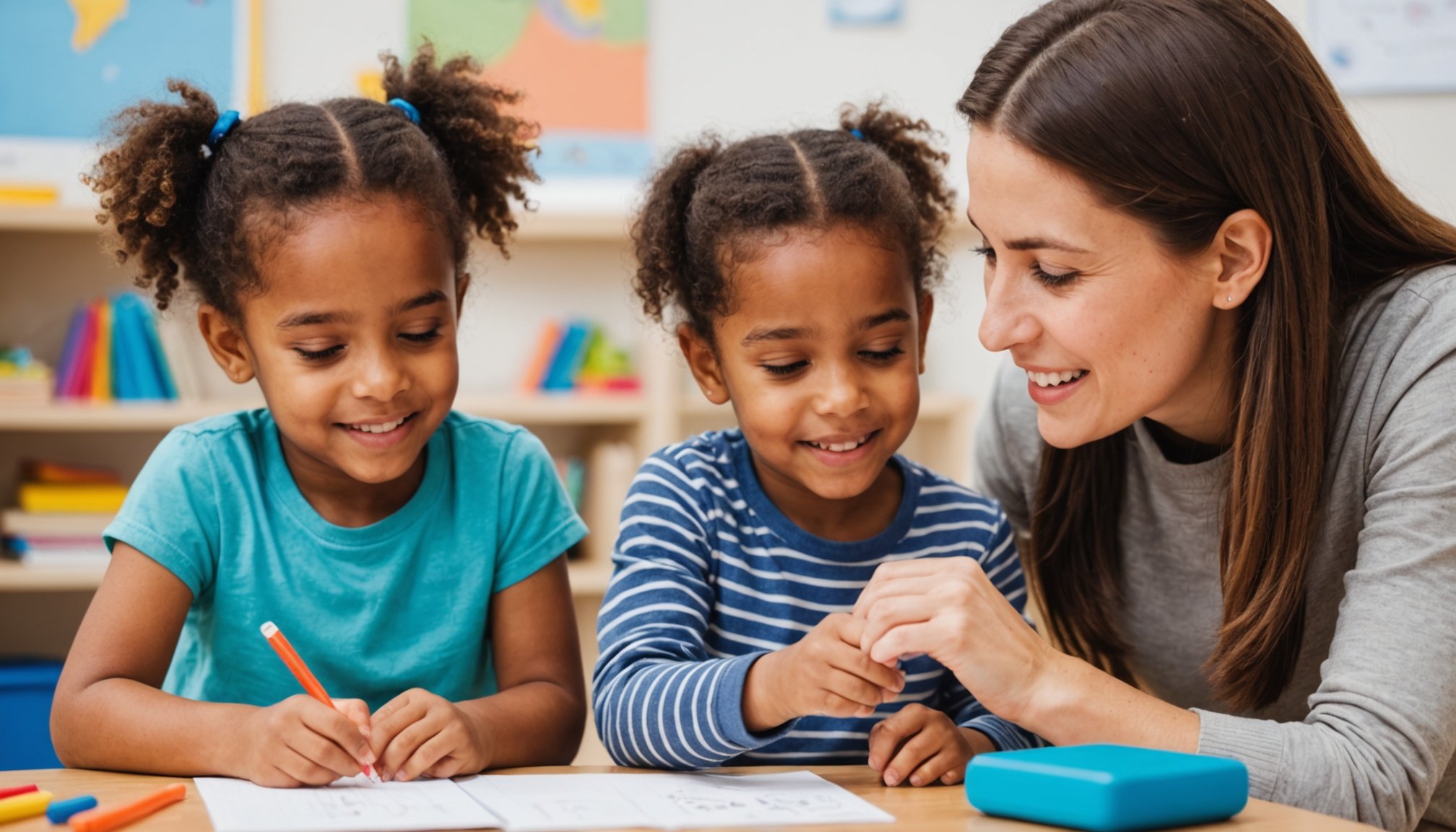Understanding Speech Delays in Bilingual Children
Navigating the world of child development can be complex, especially when it comes to speech delays in bilingual children. Bilingualism adds a beautiful complexity to a child’s developmental journey, yet it sometimes poses challenges in identifying speech delays. The first step is understanding that while bilingualism may influence the pace of speech development, it doesn’t necessarily cause delays.
Speech delays in bilingual contexts can be shaped by several key factors. Language exposure and usage frequency play a crucial role. Children who are equally exposed to multiple languages might take more time to reach proficiency in each language compared to monolingual peers. Additionally, the quality of language interaction they receive – be it rich, varied, or interactive – significantly impacts their development.
Also read : Enhancing Patient Well-Being: Strategies for UK Nephrologists to Innovate Dialysis Protocols
Recognizing the signs of speech delays early is essential. Early diagnosis and intervention not only support language development but also promote overall cognitive growth. Experts recommend using a comprehensive approach, considering the child’s entire linguistic environment. This might involve regular screenings, observational assessments, and in some cases, consultations with speech-language therapists.
Addressing speech delays in bilingual children involves sensitivity to cultural and linguistic diversity. It’s important for parents and educators to foster an encouraging environment where children feel comfortable using both languages, therefore enhancing their communication skills and confidence.
Topic to read : Exploring Innovative Strategies by UK Pain Specialists for Non-Opioid Management of Neuropathic Pain
Evidence-Based Techniques for Speech-Language Therapists
In the realm of speech therapy, evidence-based practices serve as the backbone for effective intervention strategies, providing therapists with reliable methodologies backed by research.
Techniques for Language Development
Adopting specific speech therapy techniques can significantly enhance language development in clients. Techniques such as explicit modelling and structured drill activities offer clear frameworks for understanding and practicing new language skills. By consistently applying these methods, therapists can foster an environment conducive to growth and learning.
Culturally Responsive Practices
Speech-language therapists must also incorporate culturally responsive practices into their methodologies. By adapting practices to cultural contexts, therapists show respect and understanding for clients’ backgrounds, establishing strong therapeutic relationships. This approach not only accommodates diverse linguistic backgrounds but ensures that interventions are meaningful and relevant to the individual’s life.
Incorporating Play-Based Learning
Incorporating play-based learning can be a dynamic tool in therapy sessions. Utilizing play to encourage communication helps mitigate anxiety, making sessions enjoyable and engaging. Techniques that support both languages through contextual play cater to bilingual or multilingual clients, thereby nurturing their full linguistic potential.
These strategies, when employed thoughtfully, offer a comprehensive approach to speech therapy, respecting individuality while encouraging significant improvement in communication skills.
Case Studies: Successful Interventions in the UK
Case studies in the UK highlight notable successes in bilingual speech therapy interventions. By analysing a range of intervention strategies, we can glean crucial insights into the multifaceted needs of bilingual children. Among the successful approaches, a combination of speaking and understanding both languages, tailored to individual children’s linguistic backgrounds, proves vital. This balanced method involves an integrative approach encompassing both the child’s dominant and non-dominant languages.
Analysis of Successful Bilingual Speech Therapy Cases
Several UK case studies reveal that incorporating cultural and linguistic diversity into therapy bolsters the effectiveness of interventions. Techniques include using storytelling and role-playing tailored to the child’s cultural context, which fosters a more engaging and relatable learning environment.
Lessons Learned from These Interventions
From these interventions, therapists have learned the importance of individualised treatment plans. By acknowledging that each child’s linguistic journey is unique, therapists can devise strategies that cater to specific language patterns and social environments.
Recommendations for Practitioners Based on Findings
Practitioners should consider implementing continuous mix-language exposure while ensuring supportive, culturally-aware environments. Providing resources and training for parents and caregivers surrounding these methods further enhances the efficacy of intervention strategies. Such practices can significantly improve the overall communication skills of bilingual children.
Cultural Considerations in Speech Therapy
Exploring cultural contexts in speech therapy enhances its effectiveness, particularly regarding cultural awareness and bilingual needs. Each family brings its unique language dynamics which must be understood thoroughly, establishing a solid foundation for the therapy process.
Understanding Family Language Dynamics
Families can have complex language environments, especially bilingual ones. Understanding these language dynamics is crucial. Does the child primarily speak one language or use multiple languages interchangeably? Addressing these questions forms the bedrock for tailor-made therapy strategies that honour the family’s linguistic diversity.
Tailoring Strategies to Cultural Backgrounds
Therapists must create strategies that are deeply rooted in a child’s cultural background. Cultural practices often influence communication styles, and adapting therapy techniques can lead to more effective communication. A strategy designed with respect for a family’s cultural nuances can significantly enhance the therapy’s success.
Building Trust with Families
Building strong, trusting relationships with families is critical. Achieving this starts with involving family members actively in the therapy process, fostering a familiar rapport. Additionally, clear and effective communication is essential, as it aids in alleviating misinterpretations and allows families to feel heard and respected. Encouraging open dialogue and being receptive to cultural practices build trust and ensure a more collaborative therapy environment.
Collaboration Between Parents and Therapists
In the realm of therapeutic interventions, parent involvement proves critical for ensuring the efficacy and holistic development of a child. Parents, as primary caregivers, play a crucial role in the therapy process by acting as consistent facilitators and reinforcers of therapeutic techniques. Effective collaboration between parents and therapists is foundational to achieving the desired outcomes.
Role of Parents in the Therapy Process
Parents extend the reach of therapy sessions beyond clinical settings into the home environment. By reinforcing strategies learned in sessions, they help sustain progress and adaptation. The presence of a supportive home environment can amplify the effectiveness of the therapy, increasing the likelihood of success.
Effective Communication Strategies
Clear and open communication between therapists and parents fosters a robust collaborative relationship. Regular updates on a child’s progress and areas needing attention keep both parties informed. Parents should feel comfortable discussing any concerns, ensuring a two-way dialogue that benefits the child’s development.
Joint Goal-setting
Establishing shared goals is integral to a successful therapy session. Therapists and parents should collaboratively set objectives that are specific, attainable, and tailored to the child’s needs. By aligning on bilingual development goals, for example, parents can support structured language learning at home, reinforcing skills gained during therapy.
Unique Challenges Faced by Bilingual Children
Bilingual children often face distinct challenges in speech development that require special attention. These specific hurdles can affect their language acquisition process, sometimes leading to what is known as late language emergence. One of the main factors contributing to these obstacles is the varying degrees of language exposure. Bilingual children may not receive equal exposure to both languages, which can result in uneven language skills and delay speech milestones.
The obstacles in speech therapy for bilingual children are also significant. Traditional therapy methods might not always account for the complexities of dual-language acquisition. It’s crucial for therapists to consider the child’s entire linguistic environment. Therapists need to be equipped with strategies that address bilingualism, ensuring that therapy is tailored to their unique needs.
One effective strategy to overcome these challenges is integrating both languages in therapy sessions where possible. Encouraging language use in natural settings at home can also enhance proficiency. Highlighting the importance of consistent language use within each community setting helps bridge gaps in exposure and usage. By providing a supportive environment and employing flexible intervention techniques, bilingual children can effectively overcome the obstacles on their path to language proficiency.
Relevant UK Policies and Resources
Exploring UK policies and available resources for therapists reveals a supportive framework for speech therapy, particularly concerning bilingual children.
Current Policies Supporting Bilingual Children
The UK’s educational and health policies acknowledge the unique needs of bilingual children, emphasizing inclusion and equality. The Special Educational Needs and Disability (SEND) Code of Practice is a cornerstone policy for ensuring appropriate support for these students. It encourages the development of personalized education plans and the use of multilingual assessments to accurately evaluate a child’s needs.
Available Resources for Speech-Language Therapists
Therapists can access a variety of resources for therapists, including comprehensive guidelines from the Royal College of Speech and Language Therapists (RCSLT). These guidelines provide evidence-based practices, strategies for engaging with bilingual families, and methods for integrating cultural competence into therapy. Access to bilingual materials and translation services is also facilitated, enhancing the effectiveness of these interventions.
Training and Workshops for Professionals
There is a robust offering of training and workshops aimed at professional development for therapists working with bilingual populations. Many organizations offer specialized courses that focus on bilingual language development and effective intervention strategies. These educational opportunities ensure therapists remain informed and proficient in addressing the complexities of bilingualism in speech therapy.
Summary of Best Practices for Supporting Bilingual Children
Supporting bilingual children, particularly those with speech delays, requires a nuanced and comprehensive approach. Cohesion between families and therapists is foundational for success. Key best practices emphasise creating an immersive and consistent bilingual environment. This is achieved through integrating both languages naturally in daily interactions and activities.
Collaboration among family members and speech therapists is paramount. By working together, families can reinforce language goals set by therapists at home, enhancing the child’s learning experiences in real-world contexts. Engaging in activities that incorporate both languages, such as reading bilingual books or playing language-based games, can be particularly effective strategies.
Future directions in supporting bilingual children should focus on incorporating culturally relevant materials. These materials resonate more deeply with children, making language learning a relatable and enjoyable experience. Pursuing evidence-based practices tailored to the individual needs of each child will remain essential.
Additionally, employing modern tools such as language-learning apps can provide supplementary support outside of therapy sessions, offering additional platforms for practice and reinforcement. By adopting these best practices consistently, bilingual support for children with speech delays can be significantly enhanced, fostering improved communication skills and confidence.











